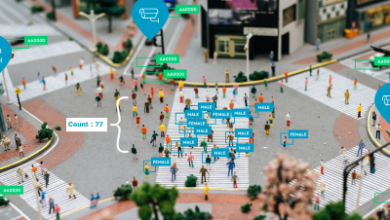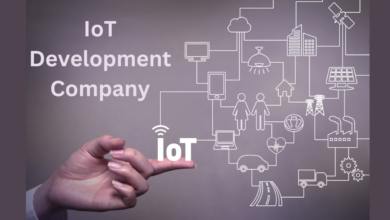Transforming Industries with Connectivity and Data Insights
IoT Solutions

In today’s fast-paced technological landscape, the Internet of Things (IoT) has emerged as a groundbreaking innovation. IoT solutions, driven by seamlessly integrating physical devices, sensors, and connectivity, have reshaped the way businesses and industries function. This article explores the importance of IoT services and how they are revolutionizing various sectors. We’ll discuss the essential components, advantages, and challenges of IoT solutions, along with real-world applications that highlight their transformative potential.
Table of Contents
- Introduction
- Key Components
- Benefits
- Challenges in Implementing
- Real-World Applications of IoT Solutions
- The Future of IoT
- Conclusion
Introduction
The Internet of Things refers to a network of interconnected physical objects, devices, and sensors that collect and exchange data with minimal human intervention. These devices come equipped with sensors, software, and other technologies, allowing them to collect and transmit data over the Internet. IoT solutions harness this network to enable data-driven decision-making and automation across various industries.
IoT services are not limited to a single sector but span across numerous domains, including healthcare, manufacturing, agriculture, transportation, smart cities, and more. The potential of IoT lies in its ability to provide real-time data and insights, leading to increased efficiency, reduced operational costs, and improved decision-making processes.
Key Components of IoT Solutions
IoT consist of several essential components that work in harmony to achieve their goals:
a. Sensors and Devices
At the core of any IoT solution are sensors and devices that gather data from the physical world. These can include temperature sensors, GPS modules, cameras, and various other specialized devices, depending on the specific application.
b. Connectivity
IoT devices require a reliable and secure means of connecting to the internet. This connectivity can be established through various technologies such as Wi-Fi, cellular networks, Bluetooth, LoRaWAN, or even satellite connections.
c. Data Processing
The data collected by IoT devices is often unprocessed and raw. Data processing components, frequently located in the cloud or at the edge, clean, analyze, and store this data for further use. Machine learning algorithms are often applied to derive meaningful insights from this data.
d. User Interface
For humans to interact with IoT, a user interface is essential. This can be a mobile app, a web dashboard, or any other means of presenting the data and enabling user interaction.
3. Benefits of IoT Solutions
IoT solutions offer a wide array of benefits to organizations across different sectors, driving efficiency, innovation, and competitiveness. Here are some of the key advantages:
a. Improved Efficiency
Internet of things automates many tasks that were previously manual, saving time and reducing the likelihood of errors. For example, in manufacturing, IoT-enabled machines can self-diagnose and schedule maintenance, reducing downtime.
b. Cost Reduction
By optimizing operations, reducing energy consumption, and predicting maintenance needs, organizations can significantly cut operational costs.
c. Enhanced Decision-Making
Real-time data and analytics generated by IoT solutions enable better decision-making. For instance, in agriculture, IoT devices can provide information on soil conditions and weather, helping farmers make informed planting and irrigation decisions.
d. Predictive Maintenance
In sectors such as transportation and manufacturing, IoT sensors can predict equipment failures, allowing organizations to schedule maintenance proactively rather than reactively.
e. Increased Safety
In industries like healthcare and construction, IoT enhance safety by monitoring environmental conditions, detecting potential hazards, and alerting relevant personnel.
f. Customer Experience
IoT can transform the way businesses interact with their customers. For instance, in retail, they can provide personalized recommendations and streamline the checkout process.
4. Challenges in Implementing IoT Solutions
While the benefits of IoT are substantial, implementing them is not without challenges:
a. Security and Privacy
The vast amount of data generated by IoT devices raises concerns about security and privacy. Ensuring data is protected and used responsibly is paramount.
b. Interoperability
Different devices and platforms may not communicate seamlessly. Ensuring interoperability and standardization is an ongoing challenge.
c. Scalability
Scaling IoT can be complex. Organizations must plan for growth, considering the increasing number of devices and data volumes.
d. Data Management
Managing and making sense of large datasets generated by IoT devices requires robust data management strategies and tools.
e. Energy Consumption
Many IoT devices are powered by batteries, and optimizing energy usage is critical to extending their lifespan.
5. Real-World Applications of IoT Solutions
The versatility of IoT solutions is showcased in numerous real-world applications:
a. Healthcare
In healthcare, IoT devices are used for remote patient monitoring, ensuring patients receive proper care while reducing hospitalization rates.
b. Smart Cities
Cities around the world are becoming smarter with IoT applications. From smart traffic management to waste management, these solutions improve urban living.
c. Agriculture
Farmers employfor precision agriculture, managing irrigation, and monitoring crop health.
d. Manufacturing
IoT has revolutionized the manufacturing industry with predictive maintenance, quality control, and process optimization.
e. Transportation
IoT-enabled vehicles and traffic management systems enhance transportation safety and efficiency.
f. Retail
Retailers use IoT for inventory management, customer analytics, and smart shelves that notify staff when restocking is needed.
6. The Future of IoT Solutions
The evolution of IoT is ongoing, and the future holds exciting developments:
a. Edge Computing
Edge computing will become more prevalent, allowing data processing to occur closer to the data source, reducing latency and bandwidth requirements.
b. 5G Connectivity
The rollout of 5G networks will enable faster and more reliable connections, supporting the growth of IoT applications.
c. Artificial Intelligence
AI and machine learning will play a more significant role in IoT services, allowing for more advanced analytics and automation.
d. Integration with Blockchain
Blockchain technology will enhance the security and trustworthiness of IoT solutions, particularly in supply chain and healthcare applications.
e. Sustainability
IoT solutions will be used to drive sustainability initiatives, such as optimizing energy consumption and reducing waste.
7. Conclusion
IoT have transformed the way industries operate by providing real-time data, automation, and enhanced decision-making. With the continued growth of IoT applications and advancements in technology, the benefits of these solutions will only increase in the future. Organizations that embrace IoT are well-positioned to improve efficiency, reduce costs, and gain a competitive edge in their respective industries. However, they must also address the challenges associated with security, interoperability, and scalability to maximize the potential of IoT solutions in their operations. As the IoT landscape continues to evolve, staying informed and adopting the latest technologies will be key to success in the connected world of tomorrow.
Frequently Asked Questions
Q1: What is IoT, and how does it work?
A1: IoT stands for the Internet of Things. It is a network of interconnected physical objects, devices, and sensors that collect and exchange data over the internet. These devices are embedded with sensors and software, allowing them to gather and transmit data, often without human intervention.
Q2: What are the key components of an IoT solution?
A2: IoT solution typically consist of four key components: sensors and devices that collect data, connectivity to transmit data, data processing to analyze and store the data, and a user interface for interaction and decision-making.
Q3: What are the benefits of implementing IoT solution?
A3: IoT solutions offer numerous benefits, including improved efficiency, cost reduction, enhanced decision-making, predictive maintenance, increased safety, and improved customer experiences.
Q4: What are the main challenges in implementing IoT solutions?
A4: Challenges in implementing IoT solution include security and privacy concerns, interoperability issues, scalability challenges, data management complexities, and the need to optimize energy consumption for IoT devices.
Q5: In which industries are IoT solutions commonly used?
A5: IoT solution are used in a wide range of industries, including healthcare, smart cities, agriculture, manufacturing, transportation, retail, and more. These solutions are adaptable to various sectors to improve operations and customer experiences.






